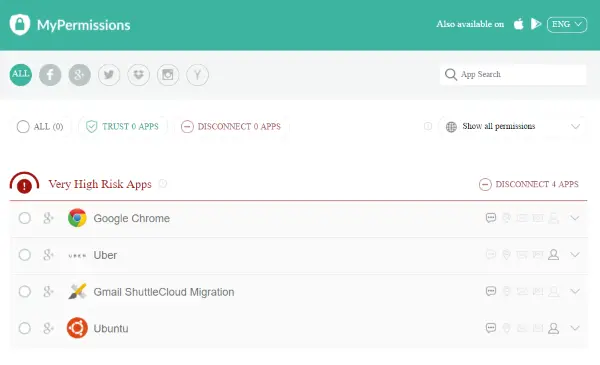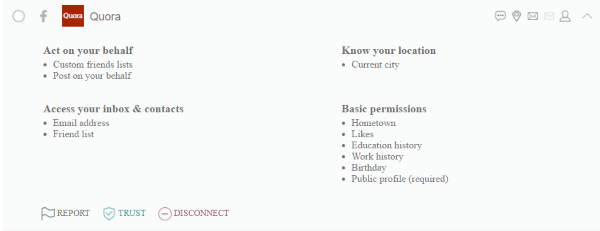Do you read the entire page while you were signing up for an app using your Facebook or Google account? Well, you granted some permissions and maybe you are not sure about that. As the internet grows, the interconnectivity between applications grows as well. And in our day-to-day tasks, we grant a lot of applications with permission to access our personal info and some other content. With time, the number of connected applications increases tremendously and it is difficult to monitor them. MyPermissions Privacy Cleaner extension for Google Chrome browser lets you monitor all the connected apps and see what permissions you’ve granted on your Windows PC.
MyPermissions Privacy Cleaner for Chrome
Privacy Cleaner is available to download as a mobile application or as a browser extension. This review is for the Chrome browser extension available on Google Chrome Web Store. Once you’ve downloaded and installed the extension, all you need to is hit that green button to the right of the address bar to open Privacy Cleaner.
Privacy Cleaner is currently compatible with Facebook, Google Account, Twitter, Dropbox, Instagram and Yahoo Account. The best part about this extension is you don’t need to log in again if you are already logged into these social platforms.

Finally, it is time to actually view all the connected apps to your different social accounts. The apps are well categorized by their risk profile. The connected apps are categorized as Very High Risk, High Risk, Medium Risk, Low Risk and Unknown Risk profiles.
Corresponding to each and every application is displayed the currently granted permissions. There are five icons and you can click on the application to view more details about the permissions you’ve granted to that particular application. Also, the social platform to which this application is connected is also displayed along with it.
Once you’ve clicked upon the application to view full details, you can exactly see what kind of permissions have been granted and how that app can use your permissions. All the aspects such as locational permissions, storage permissions, information permissions, contacts and messaging permissions are covered under these details.
For more flexibility, you can sort the applications by their social platform, or on the basis of their permissions. Moreover, you can search for a particular application as well.

If you’ve found anything suspicious, you can disconnect the app from your account or report it. To report an application, you need to write a short description about what you’ve found suspicious and submit it. To disconnect an application, all you need to do is hit the corresponding ‘Disconnect’ button. The app would automatically be disconnected from your account and all the permissions granted will be removed thereof.
Or you can mark the applications as Trusted. Trusted applications won’t show up again in risk profiles and they will be marked with a green flag.
MyPermissions Privacy Cleaner is a great privacy protection suite for all your social platforms. The wide support and the built-in database of more than over 3 million applications make it the best tool to have. And the various platform-based choices offered makes the tool more versatile and easily accessible. The tool is pretty simple to use and operate. Even if you don’t want to remove any applications, you can use this tool to simply view the permissions you’ve granted to different applications over time.
Visit the Chrome Web Store to download MyPermissions Privacy Cleaner for the Chrome web browser.
What do Chrome extensions have access to?
It depends from extensions to extensions. For example, some extensions capture almost everything you type on a website. On the other hand, some extensions can display notifications at times. To check what permissions an extension has, you can open the Extensions panel, click on an extension to find more details, and check the Permissions section.
How do I view Chrome extension permissions?
To view the Chrome extension permissions, you need to open the chrome://extensions first. Then, choose an extension and click the Details button. Following that, head to the Permissions tab to find all the given permissions.
Leave a Reply